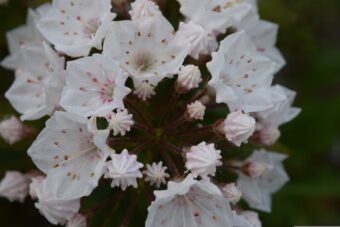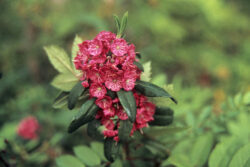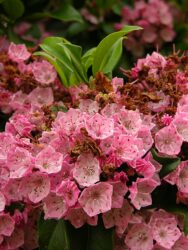In this article, we will discover how to grow the beautiful flowering shrub of Kalmia in containers. Kalmia is a small species of evergreen shrub that belong to the Ericaceae (the Erica) family. They are native to North America and Cuba, where they are found growing either in wet, acidic bogs or dry, sandy soils.

Kalmia was named by the famous Botanist Linnaeus to honour his friend Pehr Kalm, who brought it back to the UK in the mid-18th century. The most popular species when not in flower can be easily mistaken for a Rhododendron. The leaves are markedly long from 2 to 12cm and are often single lance-shaped. When it flowers the confusion with rhododendron stops. The flower buds are like miniature Chinese lanterns, which open to shallow bowled flowers that are crimped at the edges. The blooms are normally seen any time between April and June. The flowers are typical 1 to 3cm wide and are followed by five lobed capsules that spilt revealing numerous small seeds.
One note of caution is that the plant is toxic if eaten, especially so to sheep, so protect your animals and children from consuming the plant. The plant is also a known skin irritant, so wear gloves when touching it.
Find out how to grow this acid-loving shrub in containers in this article.
GROWING KALMIA IN CONTAINERS

They prefer to be grown in acidic conditions like their close cousin, the Rhododendron. First, choose a container that is large enough and will suit the shrub in question. It must also look balanced and not stick out.
No matter what you choose make sure it has some holes at the bottom. Not too many but enough to allow any excess water to drain away. On top of this, you need to create moisture-retentive growing media. To do this mix a handful of manure with a good quality ericaceous compost. Fill the container to within 5cm below the top rim with this mixture.
Dig a hole at the centre of the container slightly bigger than the root ball it came in the original container that you bought it in. Remember whilst handling the plant, you will need to wear gloves. Drop the plant in the hole so that the top of the root ball is at the same level as the top surface of the compost. Backfill with the growing media so that no gaps can be seen, using more compost if you deem it to be necessary. Firm the plant in and water very well using rainwater. At this stage, you can mulch the top surface of the container with leaf mould or pine needles.
THE BEST GROWING CONDITIONS

They like to be in partial shade if you cannot be bothered to water regularly but if you are then they can take full sun. As the most likely species you will find grows in moist, acidic conditions, it is best to water with rainwater when it feels dry to the touch on the surface. Water with rainwater until it just flows through the drainage holes.
They are not particularly hungry plants but you can in early spring give an annual dressing of slow-release ericaceous fertilizer to get it through the growing season.
Pruning is not required at all but you can remove branches if it is absolutely necessary. It is best to leave the shrub alone as much as possible. You will need to remove spent flowers after blooming in early summer to tidy the plant up.
To propagate you can plant semi-ripe cuttings in a cold frame in summer or layer shoots to replant next year.
PESTS AND DISEASES
In terms of pests, mealybugs and adult vine weevils can be a problem. Best dealt with by using a systemic insecticide that will be effective against these or by using nematodes that can deal with adult weevils, Luckily in terms of diseases, they do not readily suffer from any. A strong plant will take pest attacks very well.
VARIETIES TO GROW

The usual species to grow is the 2m tall Kalmia latifolia, where in June the oval glossy green leaves are covered in pink flowers. Varieties to look for are ‘Ostbo Red’ which has deep pink flowers and ‘Olympic Fire’ which produces red flowers.
The other species that you can find is Kalmia angustifolia ‘rubra’ which grows up to 1m tall and looks more like an Azalea, with its rosy red flowers over a long period in May and June.
For a true dwarf species that only grows up to 50cm high is Kalmia polifolia which flowers in April.
CONCLUSIONS
In this article, we have discussed how to grow the beautiful shrub of Kalmia in containers. They are easy to grow, easy to care for, not even needing to be pruned. They make a great addition to the container garden if they are grown amongst rhododendrons or other acid-loving plants.
Why not grow one today?
If you have any questions or comments that you wish to make on growing kalmia in containers, please do so in the comment box below.
Happy Kalmia growing.
